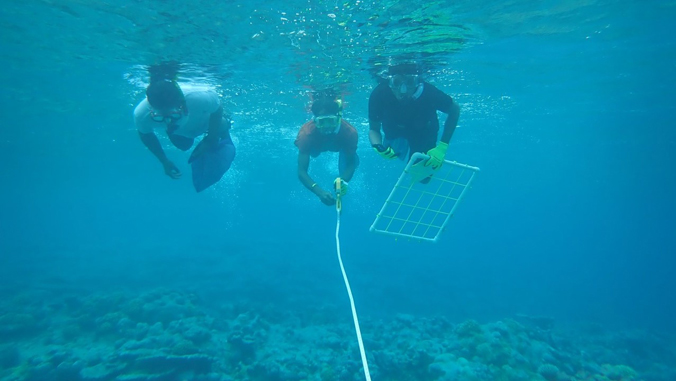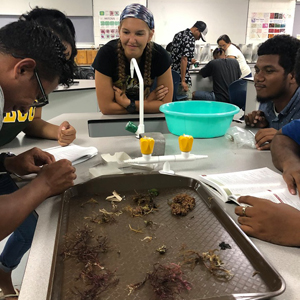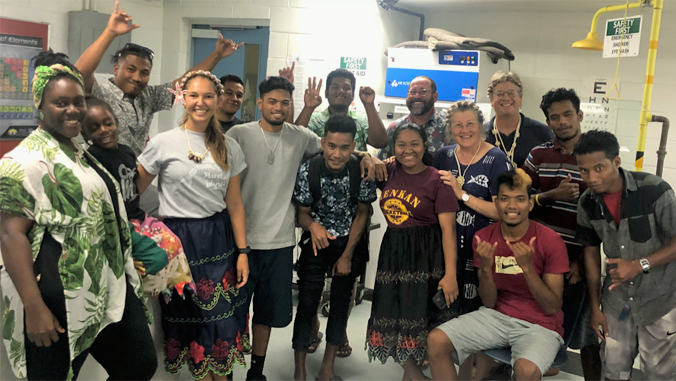
As part of the Marshall Islands Nearshore Training (MINT) program, University of Hawaiʻi at Hilo faculty led two UH Hilo students and eight College of the Marshall Islands (CMI) students throughout Majuro and Arno Atoll collecting data on water quality, algae cover and reef composition. The students became proficient at field research methods and identification of the different types of corals and algae surrounding their islands.
UH Hilo undergraduate Sabrina Bejang did not think she would ever choose marine biology for a career. Bejang, like many young Marshallese women, grew up wary of the ocean and knew little of the coral reef systems that make up Majuro atoll, the capital of the Republic of the Marshall Islands. Then she took an introductory marine science course as a student at CMI that changed the trajectory of her future.
Bejang, now a junior at UH Hilo majoring in marine science, and recent UH Hilo graduate Gordon LeBehn were selected to participate in the eight-week “bootcamp” for budding Marshallese marine scientists.

UH Hilo Associate Professor Steve Colbert, Professor Karla McDermid and marine science/biology undergraduate student Alexandra Runyan flew to the atoll nation to lead the place-based learning program.
“They live on atolls and they rely heavily on their marine resources,” says Colbert. “There’s a lot of programs going on there to understand their marine resources, but there are not local people trained to take those positions. Now you have these 10 students who were trained in these methods and have done research themselves in the Marshall Islands.”
The students did the research themselves and the skills they gained will greatly benefit the communities and environment in the Marshall Islands.
“A lot of people from the Marshallese government and NGO conservation community were excited about the MINT program and were asking us if we had any students that could go join them for upcoming research cruises,” says McDermid. “These students already have the skills. They learned how to use the Coral Point Count software package for analyzing coral reefs and carry out field research to assess coral cover, algal growth, and nutrients in the water. This experience gives these 10 students a jumpstart in terms of career opportunities. It is also a recruitment tool because two students expressed interest in coming to UH Hilo.”
Undergraduate training partnership

This collaborative MINT program was funded through a National Science Foundation Rapid Response Research grant, “Pacific Island Reefs Under Siege–An Undergraduate Training Partnership,” secured by UH Hilo Professor Rebecca Ostertag and Pacific Internship Programs for Exploring Science Director Sharon Ziegler-Chong.
Ostertag says the resulting MINT program was designed to shore up expertise in both the students and faculty in a location in need of experienced marine scientists.
“The main idea was that the UH Hilo faculty would provide expertise and capacity building, and would go to the Marshall Islands to provide training for the students and for the CMI faculty,” explains Ostertag. “Part of this is to enhance the marine science degree at CMI by giving the faculty more tools and training in how to do research in their environment. The UH Hilo faculty were there to help lead the training of the students and provide more training to the faculty.”
The program was a partnership involving UH Hilo, College of the Marshall Islands, UH Sea Grant College Program, the Coastal Management Advisory Council of the Marshall Islands, the Marshall Islands Conservation Society, the Marshall Islands Marine Resources Authority and the Pacific Islands Ocean Observing System.
Read the full story at UH Hilo Stories.
—By Leah Sherwood, a UH Hilo graduate student in the tropical conservation biology and environmental science program

